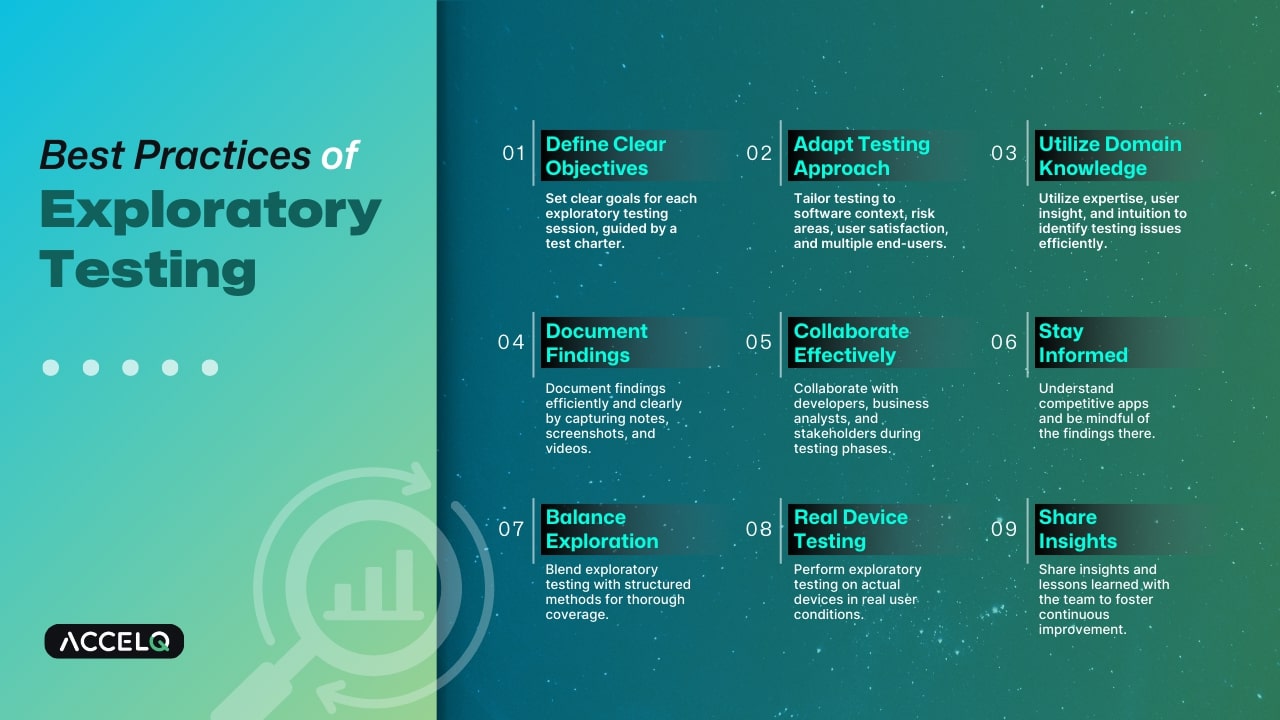What is Exploratory Testing, and what is its role in Agile practices?

Exploratory Testing is an approach that allows product testers to find bugs and errors without using a script or test cases. It basically encourages testers to think creatively and simulate real-world usage based on their experience by mimicking the actions of end users. This type of software testing usually involves very little planning, and testers make decisions on the fly while testing features.
What is Exploratory Testing in software testing?
Exploratory testing involves designing and executing tests simultaneously. Unlike traditional testing methods that rely on a clear plan and predefined test cases, exploratory testing encourages testers to explore and discover potential testing scenarios in any application.
Exploratory Testing for software testing helps testers focus on a process with basic test ideas to explore the application first. They can then identify additional test cases and use a more structured approach using predefined test cases to test the application effectively. Along with a structured approach to software testing based on predefined test cases, this type allows testing teams to convert a user story into a test case using sequences based on user persona.
SUGGESTED READ - Assistive tools for performing Exploratory Testing
Why use Exploratory Testing?
- Exploratory Testing in agile is particularly beneficial in Agile environments and areas of iterative development.
- It helps Agile teams with quick feedback loops, as testers can identify issues and refine their testing approach in real-time.
- It also helps teams identify edge cases that could have been missed in a traditional testing approach.
- It speeds up the process of documentation and helps create the feedback loop.
- Integrated exploratory Testing with tools like Jira helps export recorded documentation to test cases directly.
How to perform exploratory Testing:
- Define the target and scope of the test. Remember, this should be short and include rapid Testing. Each exploratory testing strategy has only one objective to maintain focus.
- Define testers/testing teams clearly- paired efforts work better.
- Be prepared for Testing: Prepare the test environment and ensure everything is in place, including test data.
- Perform the test according to the session parameters, including the timing defined in the charter. Document all errors and ensure they are well-researched.
- After gaining more understanding, perform a follow-up test for issues found in the initial test.
- Document the test every step of the way; stories of test sessions, learnings, conclusions, and recommendations can all be added to this document.
Exploratory Testing: An example.
Exploratory Testing techniques help discover critical defects faster as there are no test case steps. It covers more ground and helps focus more on "what ifs."
Consider testing the "Edit Bookmark" functional area in a product.
Two approaches can be adopted:
- One is to execute a test run.
- The other is to perform an elaborate exploratory test approach.
In the first scenario, steps outlined in the test case are followed to verify each step and record bugs. Critical bugs like crashes or data loss are likely not to occur.
In the other scenario, exploring the "edit bookmarks" section may yield results otherwise. When the regular approach and the exact steps are followed eventually, questions like, "What happens when I click Edit, delete the name, and try to save the bookmark with a blank field?" may arise. Now, the application crashes and deletes user data, and the most critical bug may have just been discovered.
Best practices of Exploratory Testing:
- Define clear objectives for each exploratory testing session; pay attention to the need for a test charter.
- Adapt the testing approach to the software’s context and risk areas, multiple end-users, and user satisfaction.
- Combine domain knowledge, user perspective, and intuition to uncover issues in the testing process.
- Capture notes, screenshots, and videos to document findings to ensure better efficiency each time.
- Collaborate with developers, business analysts, and other stakeholders during all phases.
- Understand competitive apps and be mindful of the findings there.
- Balance exploration with structured testing techniques to ensure comprehensive coverage of this Testing.
- Run exploratory Testing on real devices and real user conditions and do not fail to combine it with other testing types if needed.
- Share insights and lessons learned with the rest of the team.
Exploratory Testing in Agile
The Agile approach uses core principles of adaptive planning, early delivery, and consecutive improvement, helping to adapt and alter development easily. Exploratory Testing is highly flexible and doesn't require upfront preparation due to the absence of manual scripts; it uses information from previous sessions to drive new testing sessions. It is, therefore, implied that exploratory Testing does not assume a specific state or expected results for the system.
Effective time management
The Agile methodology concerns fixed-time "sprints" within which development teams must complete their planned tasks. Similarly, testing teams must meet testing new features in the available time frame. Exploratory Testing improves time management by directing team efforts to actual product testing instead of preparing detailed test cases. This kind of "freestyle" testing also detects software bugs or defects that are otherwise missed by "traditional" testing approaches.
Continuous improvement (CI)
In the age of DevOps and Agile, the key is to provide an environment of continuous improvement (CI), deployment (CD), and Testing (CT). The Agile framework enables CI/CD across the software lifecycle, and exploratory Testing can complement this need with its inherent design and execution. However, testing teams can continually test applications, receive feedback, and incorporate changes for an optimized product.
Effective test cases
Exploratory Testing mainly focuses on finding defects in new product features instead of existing functionalities. With exploratory tests, testers "use" the application like any end-user and find defects when using the application in a real-life scenario. Thus, it can deliver compelling test cases focusing on product features (when used by end-users) and finding critical bugs.
For instance, mobile Testing tests a mobile application and tracks defects in various user scenarios. Exploratory Testing can be applied to the approach of a "man in a car trying to reach his destination" and using techniques like:
- Using GPS navigation tools to reach his place.
- Taking a random navigation route.
- Asking his friend (or a passer-by stranger) for the right direction
Beyond just Testing
As the business focus shifts from merely performing "manual" or repetitive tasks to achieving business goals, exploratory Testing is much more than another testing approach. Exploratory Testing can expand the horizon by ensuring that applications work according to business expectations. It enables QA teams to design an efficient test management system that can capture and store team members' technical expertise. Besides ensuring high-quality software products, Agile teams can keep pace with frequent releases.
Improved application-performances
The diversity of the Agile team means that different stakeholders, including QA testers, product managers, UI/ UX teams, and business analysts, evaluate the product. This also means there are fewer chances of a software bug or defect "slipping through" and reaching the end user. Besides faster detection of defects, continuous improvement and Testing translate into a continual cycle of product improvements and features.
QA teams can test the applications more freely, thus improving their product knowledge and understanding.
Finally, an Agile project environment ensures that it can efficiently respond to changing customer requirements and implement the changes in the middle of a release cycle. Exploratory Testing is best adapted to evolving needs and designed to provide a stable product at any time.
ACCELQ for Automated Exploratory Testing:
As a cloud-based automation testing platform, ACCELQ breaks all silos between manual and automated Testing with its cloud-based AI codeless test automation platform. ACCELQ seamlessly automates API and web testing and can be integrated with the manual testing process, making it possible for Agile teams to manage the entire QA lifecycle effectively. Enterprises of all sizes can use ACCELQ to accelerate their Testing by adapting to the automation approach that spans test design, planning, generation, and execution. Book a consultation with us to understand more.
Geosley Andrades
Director, Product Evangelist at ACCELQ
Geosley is a Test Automation Evangelist and Community builder at ACCELQ. Being passionate about continuous learning, Geosley helps ACCELQ with innovative solutions to transform test automation to be simpler, more reliable, and sustainable for the real world.
Discover More
 Understanding Test Data Management, its challenges, tools, and techniques.
Understanding Test Data Management, its challenges, tools, and techniques.
Understanding Test Data Management, its challenges, tools, and techniques.
 Using Branching Strategies to Efficient Testing in DevOps
Using Branching Strategies to Efficient Testing in DevOps

































